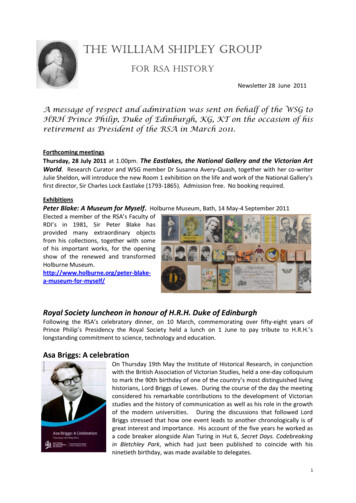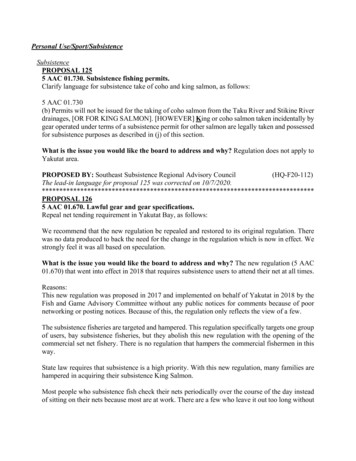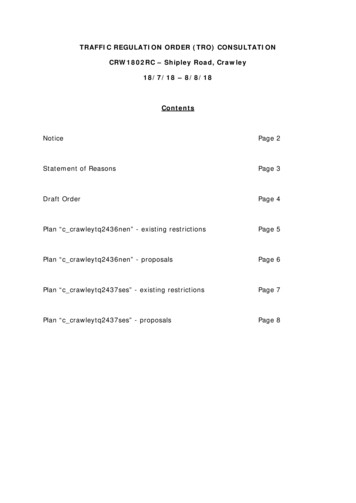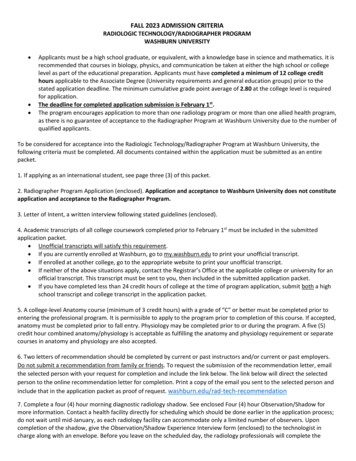
Transcription
the William Shipley groupFOR RSA HISTORYNewsletter 28 June 2011A message of respect and admiration was sent on behalf of the WSG toHRH Prince Philip, Duke of Edinburgh, KG, KT on the occasion of hisretirement as President of the RSA in March 2011.Forthcoming meetingsThursday, 28 July 2011 at 1.00pm. The Eastlakes, the National Gallery and the Victorian ArtWorld. Research Curator and WSG member Dr Susanna Avery-Quash, together with her co-writerJulie Sheldon, will introduce the new Room 1 exhibition on the life and work of the National Gallery’sfirst director, Sir Charles Lock Eastlake (1793-1865). Admission free. No booking required.ExhibitionsPeter Blake: A Museum for Myself. Holburne Museum, Bath, 14 May-4 September 2011Elected a member of the RSA’s Faculty ofRDI’s in 1981, Sir Peter Blake hasprovided many extraordinary objectsfrom his collections, together with someof his important works, for the openingshow of the renewed and transformedHolburne -for-myself/Royal Society luncheon in honour of H.R.H. Duke of EdinburghFollowing the RSA’s celebratory dinner, on 10 March, commemorating over fifty-eight years ofPrince Philip’s Presidency the Royal Society held a lunch on 1 June to pay tribute to H.R.H.’slongstanding commitment to science, technology and education.Asa Briggs: A celebrationOn Thursday 19th May the Institute of Historical Research, in conjunctionwith the British Association of Victorian Studies, held a one-day colloquiumto mark the 90th birthday of one of the country’s most distinguished livinghistorians, Lord Briggs of Lewes. During the course of the day the meetingconsidered his remarkable contributions to the development of Victorianstudies and the history of communication as well as his role in the growthof the modern universities. During the discussions that followed LordBriggs stressed that how one event leads to another chronologically is ofgreat interest and importance. His account of the five years he worked asa code breaker alongside Alan Turing in Hut 6, Secret Days. Codebreakingin Bletchley Park, which had just been published to coincide with hisninetieth birthday, was made available to delegates.1
The House of DollondOn Tuesday 17th May Neil Handley, Curator of the British Optical Association Museum gave a talk toWSG members at the College of Optometrists in Craven Street on the Dollond family of opticians andscientific instrument makers.In 1760 John Dollond discovered that he could removechromatic defects from lenses by fusing flint and crownglass, thereby producing effective optical instruments. Formany years telescopes were referred to in much same wayas Hoovers were for vacuum cleaners in the 20th century. Ithas been recorded that Admiral Lord Nelson made a specialvisit to the shop to buy a Dollond. Such was the importanceof John Dollond’s invention of the achromatic lens that hewas awarded the Royal Society’s Copley medal and electedto their Fellowship.John Dollond was elected a member of the Society of Arts in1761, shortly before his death in that same year. Four yearslater his eldest son Peter was elected and he proposed hisyounger brother John for membership in 1773. Five yearsafter Peter’s nephew, George Huggins (who changed hisname by licence to Dollond) became a partner in the familyranks of the members of the Society.Detail from J. Gillray, The Death ofAdmiral Lord Nelson in the Momentof Victory, 1805 showing his Dollondtelescope by his sidebusiness, in 1805, he too joined theThe House of Dollond also made the improved microscope, which fellow optician John Cuff designedfollowing advice by founder member of the Society of Arts, Henry Baker FRS who featured this newmicroscope in his important book Microscopes Made Easy (1744)The Society offered prizes for the production of high-quality glass in the years after Dollond’sinvention but only made two awards in 1770 and 1771 for ‘attempts’. However in the 19th centuryit played a leading role in the design of the whole instrument. Jabez Hogg in The Microscope (1855)said that the Society’s Transactions had been ‘the vehicle through which nearly all the improvementsin the construction of telescopes and microscopes have been made known to the world’.Following his talk the Curator then took the WSG members on atour of rooms of the College of Optometrists, pointing out objectsfrom the museum’s collection, such as a large Meissen figurine ofCount Bruhl’s tailor astride a bespectacled goat, as well as many fineoil portraits hanging on the walls, including that of Sir JoshuaReynolds wearing his wig glasses. The tour concluded in the packedmuseum in the basement where visitors can feast their eyes on allsorts of optical related material, including the spectacles said tohave belonged to Dr Samuel Johnson.If you wish to visit the museum by prior appointment and/or book atour of the College meeting rooms please contact the Curator, NeilHandley on 020 7766 4353 or email museum@collegeoptometrists.org. The museum website provides information onthe collections and exhibitions, including online exhibitions, etc athttp://www.college-optometrists.org/museum2
Benjamin Franklin and the Shipley FamilyOn Monday 23rd May Dr David Allan gave a talk at Benjamin Franklin House, 36 Craven Street, onBenjamin Franklin and the Shipley family.Jonathan Shipley (1676-1719) was born in Leeds and came to London to be apprenticed to [Sir]Joshua Sharp of the Livery Company of Leathersellers but who was in business as a Stationer. Sharpmade Jonathan and William Davies (1680-1765) his partners and successors. Jonathan marriedWilliam Davies’s sister Martha. They had four children, three of whom survived Jonathan’s death in1719. William Davies’s father was a Hampshire gentleman who lived at Twyford House nearWinchester, where the Shipley children were sent to live.William Shipley, Twyford House (from a photograph of a now lost painting)When he was thirteen Jonathan junior (1715-88), the eldest of theShipley children, was apprenticed in the Stationers’s Company tohis uncle William Davies but at the same sent to the historicGrammar School of Reading, which counted amongst its alumniArchbishop Laud. He was then steered towards Oxford and theChurch, he was at St John’s College and then Christchurch, BA in1735 MA in 1738. Tutor to the family of the Hon. GeorgeMordaunt, brother of the late Earl of Peterborough. He wooed andmarried in 1743 Anna Maria Mordaunt, George’s daughter andMaid of Honour at Court. He was made Rector of Silchester andSherborne St John, Prebendary of Winchester and Chaplain Generalto the Duke of Cumberland at the battle of Fontenoy (1745); DD in1748; Canon and Dean of Winchester in 1760 and Rector ofChilbolton in 1765. He inherited Twyford House and in 1769became Bishop of Llandaff and then of St Asaph. In 1770 hepreached and wrote in favour of the American colonies.Dr Jonathan ShipleyIn the meantime the Bishop’s younger brother, William Shipley (1715-1803) had obtained celebrityas the Founder of the Society of Arts and had recruited Benjamin Franklin into its membership in1755. At Maidstone in 1786 William founded a society to encourage agriculture and the arts in Kentand Benjamin Franklin lent his name to the project.3
Richard Cosway, William ShipleyBenjamin Franklin judging entries forthe Society of Arts’ polite arts premiumsIt is possible that William had introduced Franklin to Bishop Jonathan, whoof course shared his concern for the rights of the colonies. Certainly theybecame great friends and Franklin stayed with the family at TwyfordHouse. There is extant a charming letter written by him to the Bishop’swife describing the coach journey he had taken in 1771 from Twyford toLondon with her eleven year old daughter Betsy (Elizabeth Shipley) whowas being sent to boarding school. Franklin also became close to an olderdaughter, Georgiana Shipley (1755-1806) who inherited the family’s skill indrawing. The romance and tragedy of Georgiana’s later life was describedand the Shipley family’s connection with the great Orientalist Sir WilliamJones (1746-94) was also mentioned.Dr Allan concluded by referring to two historical puzzles. The engraving ofthe Parish Church of Ecton in Northamptonshire (the Franklin family camefrom Ecton) which bore the signature ‘J. Shipley’ but was much in thestyle of William Shipley’s work, and the relationship between Franklin andJohn Walter I (1739-1812) founder of The Times and printer to theSociety, who had been a pioneer of mechanical printing.Georgiana HareNaylor (nee Shipley)with her son AugustusWilliam HareSir William Jones (1746-94)Lady Joan Reid, Trustee of Benjamin FranklinHouse and Franklin scholar, who took the chair,gave the WSG a warm welcome to the Houseand made several useful contributions to thediscussion.Historical Puzzle 1:J. Shipley, Parish Church of Ecton, Northamptonshire4
Susanna Avery-Quash & Julie Sheldon, Art for the Nation: TheEastlakes and the Victorian Art World, National Gallery London,2011At the age of sixteen Charles Eastlake was awarded the Society’s SilverMedal for a drawing of Cupid and Psyche in 1810. Elected a member in1847 he took an active interest in the Society’s work, particularly onthe subject of artistic copyright. He chaired the Society’s Committeewhich succeeded in procuring the passing of the ‘Art Copyright’ Act of1862. This book accompanies the gallery’s exhibition on Eastlakewhich runs from 27 July to 30 October 2011, and WSG member DrAvery-Quash will be giving a free public lecture on the Eastlaketransformation of the National Gallery, in the Sainsbury Wing Theatre, National Gallery on Thursday28 July at 1.00pm. No booking requiredGeoffrey Cantor, Religion and the Great Exhibition of 1851, OUP, 2011The 1851 Exhibition was not only a celebration of Victorian Britain’s scientific andeconomic pre-eminence but also a hymn to the religion that underpinned it,argues Geoffrey Cantor in his recently published book Religion and the GreatExhibition of 1851. Cantor draws on sermons and extensive source material todemonstrate that it was widely understood by contemporaries that the exhibitionpossessed a religious dimension. Jews, Unitarians, Quakers, Congregationalistsand a wide spectrum of Anglicans generally welcomed the exhibition – but all fordifferent reasons.Thomas J. Schaeper, Edward Bancroft. Scientist, Author, Spy, YaleUniversity Press, 2011Schaeper has made a keen analysis of Bancroft’s correspondence anddiplomatic records to reveal in this biography whether Bancroft shouldultimately be considered a traitor to America or a patriot to Britain.In the following article WSG member Dr Sarah Lowengard, writer and historian of science andtechnology considers Bancroft’s association with the Society of Arts.A Letter from Edward BancroftEdward Bancroft was elected to the Society of Arts in 1787. He was a reasonably active member,sitting on committees, serving as Secretary of the Committee on Correspondence, sponsoring newmembers and adjudicating or consulting the submissions of others. Election was not the beginning ofBancroft’s involvement with the Society of Arts, however. Fifteen years earlier, he had submitted aninvention of his own for consideration. His letter and related materials are preserved in the Archivesof the Royal Society of Arts. The letters and related information provide a glimpse into the workingsof the Society of Arts during the middle years of the eighteenth century.5
Bancroft as petitionerAs far as we know, Bancroft first contacted the Society in May 1771, via a letter addressed to SamuelMore, Secretary of the Society of Arts.1 According to Thomas J. Schaeper, Bancroft had only recentlyreturned to London from a trip to Surinam and New England (where he had no doubt beenprospecting for new materials he might bring to Europe). 2 The timing of the letter suggests that atleast some of the work leading up to his invention had been undertaken during the voyage.Bancroft’s presentation is direct and confident, neither self-deprecating nor aggrandizing as otherpetitioners were. Bancroft has knowledge he wishes to share with appropriate colleagues. It is notclear whether Bancroft and More were already acquainted. It is possible: In addition to his duties forthe Society of Arts, More worked as an apothecary and had been an assistant to the William Lewis,one of the pre-eminent chemists in London.The subject of Bancroft’s letter is dyeing fabric. Undaunted by an earlier failure to convert a red stainused in Guyana into a commercially viable red dyestuff, Bancroft notes, he continued to search forand study colouring materials.3 He was especially interested in the problems of dyeing cotton fibres,native to Central and South America and an important commodity in Europe. Bancroft’s goal wasidentical to that of many eighteenth-century investigators into dyes and dyeing: materials andprocesses that would yield attractive colours, ones that resisted fading and were not too expensive. 4Mid-eighteenth century understanding of cotton dye techniques lagged far behind that of wool andsilk, and interest in improving knowledge was widespread. The chemistry of cotton dyeing issufficiently different that successful results demanded special attention. The higher temperaturesneeded in the dye bath could add significantly to the expense. Cotton dyed or printed by even thebest manufacturers were seldom as permanent as the same colours on wool: Colour was lost inwashing and even use. Extra problems arose when attempting to make good black-coloured cloth ascertain ingredients—especially the iron sulphates and sulphuric acid—weakened or destroyed thefibres if not carefully employed. Less deleterious methods relied on multiple dyeings, often blue, redand yellow in sequence, adding further time and expense.Bancroft brought from America a “cheap vegetable growing spontaneously and in great plenty,” thesubject of his letter to Samuel More. According to Bancroft, his experiments showed that an extractof his substance, when added to the dye bath, improved adherence of the colouring molecules tothe fibre. Dyers who used this assistant (as they are now called) obtained a better-quality colour. Nolonger would it be necessary to first dye with blue and then over dye with other colours to achieve agood, rich black. The addition of this assistant to the dye bath improved colour take-up even in lowertemperatures. Fibres were less likely to be damaged and cottons could be coloured with substancesthat ordinarily could not withstand higher temperatures. The result would be an increased range ofcolours, a more permanent result and one obtained at a lower cost.Bancroft, in his letter, explained to More that he wished to receive a premium and to publish thediscovery for the public good. A patent “would be repugnant to the vigour & extension of those arts1Edward Bancroft to Mr. [Samuel] Moore, 20 May 1771, [R]SA PR.GE/110/29/85. Other documents in thisexchange are John Arbuthnot to Samuel More, 4 April 1772, [R]SA PR.GE/110/29/88; Committee Minutes ofthe Chemistry Committee for March, 1773 Minutes of Various Premium Committees 1772–1773 [R]SAPR.GE/112/12/14; Great Britain. Parliamentary Act in Favor of Dr. Edward Bancroft, 30 May 1785 (London,1785).2Thomas J. Schaeper, Edward Bancroft, Scientist, Author, Spy (New Haven Conn.: Yale University Press, 2011),24, 30.3This red color is described in Natural History of Guyana (London, 1769), 256.4Sarah Lowengard, “Parameters of Color Quality,” The Creation of Color in Eighteenth-Century Europe 0-23150369-5. Gutenberg e (New York, NY: Columbia University Press. 2006), http://www.gutenberge.org/lowengard/B Chap01.html. Accessed June 2011.6
and of that commerce which are the natural sources of British wealth & power.” 5 Bancroft’sstatement makes obvious the purpose of his letter. An award would compensate Bancroft for hiswork without requiring that he give up his claim to the discovery this substance.Bancroft included samples of cotton coloured with his reformulated dye liquor. One set offers ninedifferent yellow-brown to black shades that (we assume) he obtained from his formula. Bancroftalso sent four larger pieces of the darker- and lighter-coloured cottons. These samples could be usedfor assessment, leaving the smaller, numbered samples intact as a separate reference tool. Byincluding both sample chart and larger pieces, Bancroft displayed an understanding of the needs andworkings of the Chemistry Committee unusual among petitioners. Many similar letters have samplesattached. Few are numbered and frequently only tiny pieces remain, as the single example washalved or quartered so that tests could be made.Bancroft’s nine numbered samplecolours. In his letter to More, hesingled out No. 7 as similar to thenankeen colour then popular inEurope, and noted that the otherswould be very suitable for use intropical climates.1Two of Bancroft’s four larger-sizedfabric samples. The odd shape ofeach piece indicates the cuttingstaken for testing.6Samples, after testing.6Bancroft’s samples were given to the calico printer John Arbuthnot fortesting, and Arbuthnot’s letter to More is also in the RSA archive.6 Inhis letter, Arbuthnot describes the tests used to assess Bancroft’sclaims. Pieces were boiled in vinegar (to simulate damage from theair) or soapy water (a quick way to test the effect of multiplewashings). The result, Arbuthnot noted, was little or no alteration tothe colour of the cotton. Arbuthnot neglected to return the samples tothe Chemistry Committee, an omission he noted in his letter.Normally, this would mean that the committee could see forthemselves Arbuthot’s assessment but the extra fabric provided byBancroft meant that the Chemistry Committee was able to repeat thetests. Together, they confirmed the statements of both Bancroft andArbuthnot. This set of test samples is also in the RSA archive.5Bancroft to More, cited above.Arbuthnot to More, cited above. John Arbuthnot (1728/9-1797), owner of the Ravensbury printworks, was afrequent judge of submissions relating to textiles.67
ConclusionsDespite the positive reports, Bancroft received no award from the Society and this dye assistant wasnot made available to the public in this form. The Chemistry Committee minutes for March 1773indicate that Bancroft withdrew his work from consideration at that time. 7 No explanation exists forthis action, and there are a number of possible reasons. I have suggested elsewhere that theadjudication process was, for Bancroft, a means to bring his discovery to the attention of themanufacturers most likely to use it.8 As an outsider—a colonial with no formal training as a dyer and,in 1772, someone still making his name as a natural philosopher—approval of the Society wouldenhance the credibility of his discovery. It may be that the reward, mentioned to Bancroftinformally, did not meet his financial needs. He may have discovered that it was impossible to obtainthe substance in sufficient quantity. Perhaps, caught up in other work, Bancroft found he had notime to oversee dissemination of a new dye method or that it was similar to somethingrecommended by William Lewis.9 Or perhaps continued chemical research led Bancroft to considerquercitron, the subject of his 1775 patent, a more viable and valuable commodity. Whatever thereason, Bancroft’s later participation in the Society of Arts proves the episode did not end inrancour. And Bancroft’s early encounter with the Society of Arts perfectly highlights the approach ofthe Society in that period: open-minded, deliberate and equally encouraging to individuals andindustry.Dr Sarah LowengardNuffield PlaceNuffield College has presented the former home of WilliamMorris, Lord Nuffield, between Wallingford and Nettlebed tothe National Trust. The founder of Morris Motors broughtthis country house designed by the architect Oswald Milne(1881-1968) in 1933 and lived here until his death in 1963.Despite his extraordinary philanthropy – he gave away morethan 30million (equivalent of 11bn today) - to supporteducation, hospitals and medical research, Lord Nuffield neverforesaw that there would be interest in him and the life he led athome, but Richard Henderson, the Trust’s General Manager, saidthat ‘this acquisition is important; it is all about the man and thespirit of the place. The house remains just as the greatindustrialist left it. It retains most of the furniture acquired byLord and Lady Nuffield together with the robes worn to officialfunctions, personal letters, books, framed cartoons andphotographs. The National Trust is calling on its supporters tohelp them raise 600,000 to provide visitor facilities to enable theproperty to be opened to the public as soon as possible. KevinMinns, Chairman of the Friends of Nuffield Place and great-great7[R]SA Committee Minutes for the Chemistry Committee, 18 Feb 1773, cited above.Sarah Lowengard, “Cultures of Science, Cultures of Technology,” The Creation of Color in Eighteenth-CenturyEurope 0-231-50369-5. Gutenberg e (New York, NY: Columbia University Press. 2006),http://www.gutenberg-e.org/lowengard/A Chap02.html#39. Accessed June 2011.9Lewis was the author of the Commercium Philosophico-Technicum (London, 1763), which included asignificant section on black dyeing.88
nephew of Lord Nuffield, said that by accepting this property the National Trust had provided awonderful opportunity to preserve the legacy of William Morris and his home ‘once and for all’.Lord Nuffield’s remarkable philanthropic activities were recognised by the RSA in 1937 when theDuke of Connaught, President of the RSA, took great pleasure in presenting him with the gold AlbertMedal ‘for services to industry, transport and medical science’. The Duke congratulated LordNuffield on being ‘a great employer of labour, even in the most depressed periods, and hadimproved the transport powers of the world and thereby increased the facilities of commerce,especially in your own country’. Your wealth you have applied not to yourself but to theimprovement of trade, commerce and science, all of them aiding the happiness and well-being of allclasses of people’. In returning thanks Lord Nuffield said that the award of the medal ‘had touchedhim almost more than anything in his life’. He added that ‘one of his earliest memories was of hisparents’ admiration for the Prince Consort, and that impression had remained with him through hislife. To receive a medal instituted in his memory from the hands of his son was an honour which heappreciated more than any he had yet received.ObituaryRobert Heritage CBE, RDI 1927 - 2010The death in 2010 of the distinguished designer, Robert Heritage, was largely overlooked in theworld of obituaries. Robert s wide ranging and varied career as a furniture and product designerrepresents a major contribution to 20th century design, ranking alongside that of Robin DayOBE RDIRobert, or Bob, as he was widely known, trained at the Birmingham College of Art from 1942through to 1946 before going on to the Royal College of Art where he trained under the direction ofProfessor R D Russell RDI in the School of Wood, Metals and Plastics. After leaving the College heeventually went on to set up his own design practice, andbegan to work as a consultant to many of the leading British,high quality, modern furniture manufacturers of the day,notably Archie Shine, Beaver & Tapley, Gordon Russell andHeals, mainly designing domestic living and dining roomfurniture.His work for Beaver and Tapley included a very successfulrange of wall hung storage units. The Tapley SL group had aunique selling feature - each unit was supplied with a wallfixing batten with an integral spirit level!In 1967 Bob was commissioned by Cunard to design a diningchair for the QE2. The innovative design he conceivedemployed new technology in the use of adhesives in thebonding together of aluminium castings. The chair was madeby the Ernest Race Company.RobertHeritage,Diningchaircommissioned by Cunard for QE2 andmade by the Race Company, 1967He was also well respected for his work as a product designer, which included lighting for ConcordLighting, Rotaflex, GEC and Technolyte, cutlery for Yote and clocks for Smiths Industry. His timelessdesigns remain classics of the period.9
A highly talented and modest man, he was appointed a Royal Designer for Industry (RDI) in 1963,and some years later he was appointed Professor of the School of Furniture at the Royal College ofArt - 1974 - 1985He received the CBE in recognition of his outstanding achievements as a Designer and for his workfor British Industry for over 50 years.Ray LeighFormer Chairman, Gordon Russell LtdLoan from RSA collectionThe RSA will be lending its portrait of The Queen painted by Justin Mortimerin 1998 to the National Portrait Gallery’s touring exhibition of sixty of themost remarkable portraits of Elizabeth II to mark the monarch’s DiamondJubilee in 2012.The exhibition will open in Edinburgh in June beforemoving onto Belfast in October. It will then show at the National Museumof Wales in Cardiff from 4 Feb to 29 April 2012 before being put on show inLondon from May to October 2012.2011 marks the centenary of the death of Sir William John Crossley. At the age of twenty-three heset up, with his brother, the engineering firm of Messrs Crossley Bros Ltd in Manchester. They soonmade a reputation as gas-engine manufacturers. In 1885 they were awarded the gold medal offeredunder the Howard Trust by the Society of Arts at the International Inventions Exhibition for the‘Otto’ gas-engine and in 1889 the Society awarded them another medal. Sir William found time formuch public work. He became President of the Manchester Young Men’s Christian Association,treasurer of the United Kingdom Alliance, chairman of the Manchester Hospital for Consumptionand Diseases of the Throat, a member of the Cheshire County Council and a Justice of the Peace forManchester and Cheshire. He was also one of the original promoters of the Manchester Ship Canal,of which he was elected a director. He stood for the Altrincham Division at the General Election in1906 and defeated Coningsby Disraeli as candidate.Sir William built and furnished, at his own expense, a sanatorium in Delamere Forest, Cheshire forthe treatment of consumptive patients from Lancashire town. In recognition of his public serviceshe was awarded the freedom of the city of Manchester, and in 1909 he was created a baronet. Hewas elected a member of the Society of Arts in 1884.Honorary Patron: Lord Asa Briggs of Lewes FRSA. Honorary President: Dr David Allan, FRSA; Honorary VicePresidents: Gerry Acher, CBE, LVO, FRSA; Sir Paul Judge, FRSA; Professor Franz Bosbach, Director, Universityof Duisburg-Essen. Honorary Benefactor: Ronald Gerard OBE, KStJ, FRSA. Honorary Member: HermioneHobhouse MBE; Committee: Dr Nicholas Cambridge FRSA (Chair); Dr David Allan FRSA (Director of Studies);Prof John Davis FRSA (Deputy Chair); Anthony Burton, FRSA; Mrs Susan Bennett, MA, FRSA (HonorarySecretary and Treasurer): Observer; Rob Baker, RSA Head of Archives and Library10
microscope in his important book Microscopes Made Easy (1744) . Jonathan Shipley (1676-1719) was born in Leeds and came to London to be apprenticed to [Sir] Joshua Sharp of the Livery Company of Leathersellers but who was in business as a Stationer. Sharp made Jonathan and William Davies (1680-1765) his partners and successors. .










